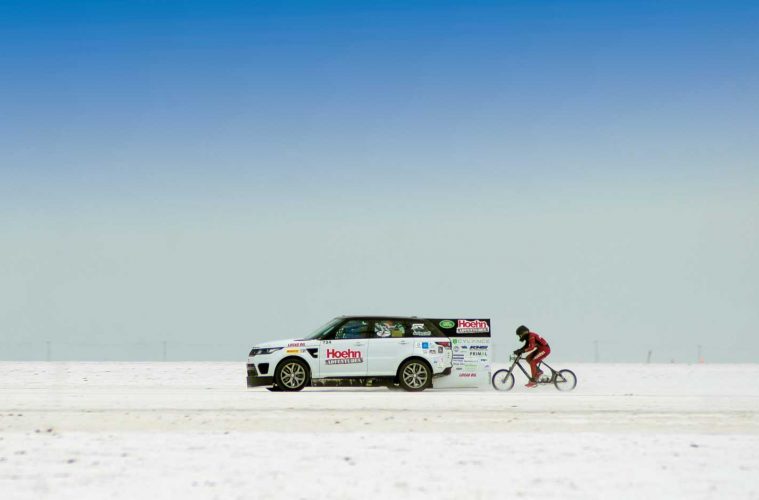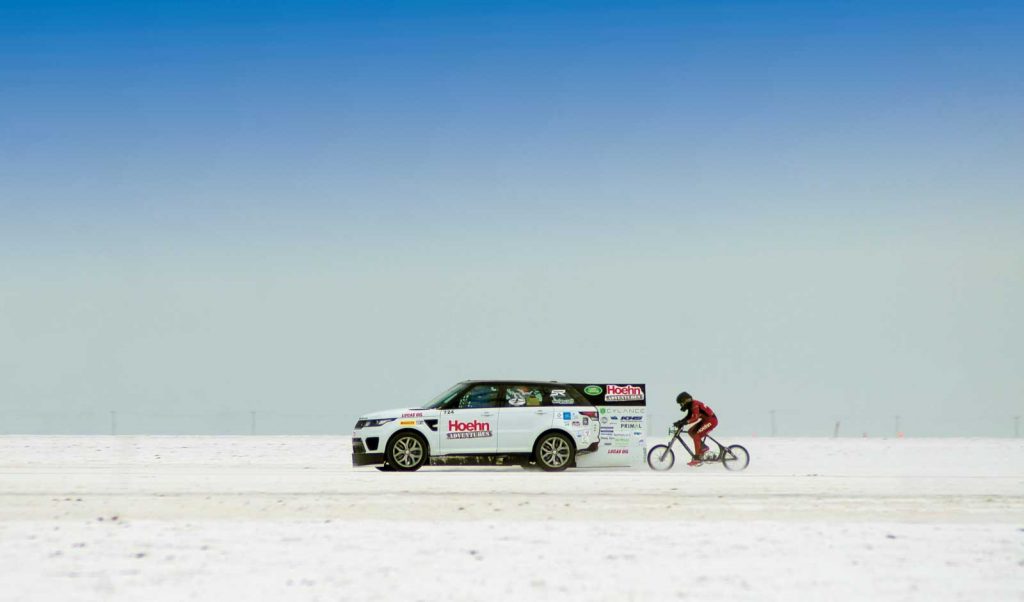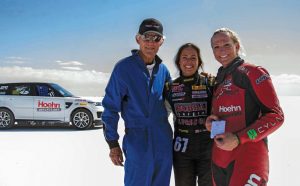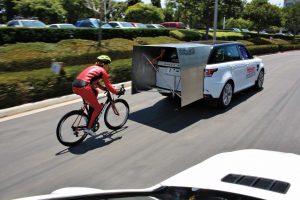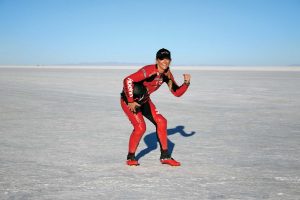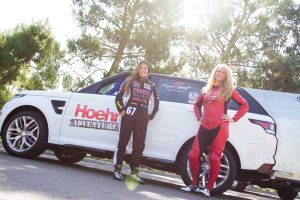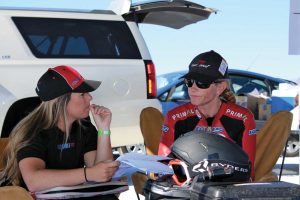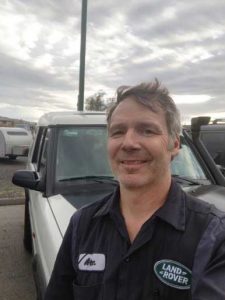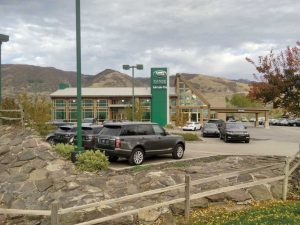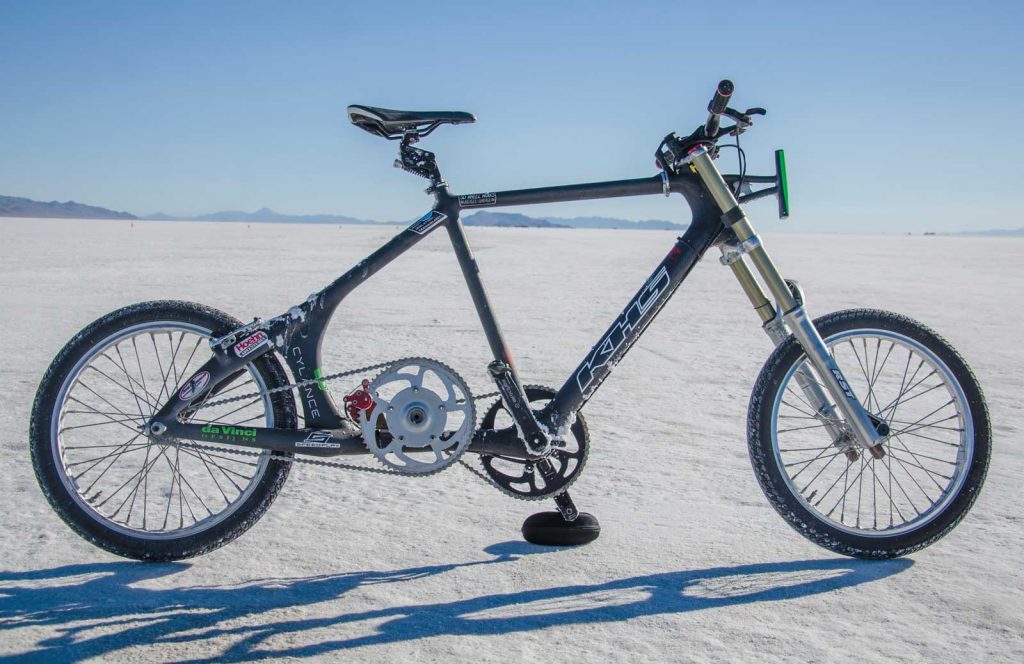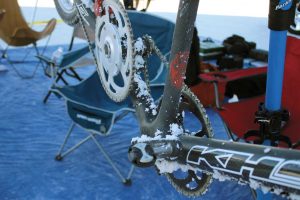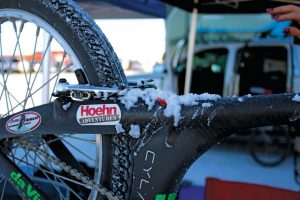Back in the 80s, Land Rover pasted “Go Faster” stripes on the side of 110’s. Today’s Range Rover Sport SVR needs no such assistance, and last September, a specially prepped one took Project Speed’s Denise Mueller to a world bicycle speed record of 147.7 mph at the Bonneville Salt Flats.
The records had previously been set and held by men. Indeed, the coach of Project Speed, John Howard, once held the world’s bicycle top speed record of 152 mph (the current record is 167 mph).
Denise Mueller pedaled a specially built bike [see Sidebar –ed.], while riding the draft of a Range Rover SVR piloted by professional racecar driver Shea Holbrook. Not surprisingly, the Range Rover came through Land Rover Carlsbad (CA) and Hoehn Adventures. That family dealership provided the Range Rovers and LR4’s used by Jo Hannah, Susanah and Karen Hoehn during the recent Rallye Aïcha des Gazelles in Morocco [see Summer 2015 issue –ed.] and the Rebelle Rally in the US this fall. The Range Rover Sport SVR received only minor modifications to permit it to run at over 150 mph for several miles on the Salt Flats. A specially designed aluminum fairing, created by Gary Castillo of Design Craft Fabrications, Huntington Beach, CA, was installed on the rear to funnel the draft that helped propel Denise’s bike.In case you’re thinking of trying this at home, here’s how you would do it. You would tether your bike to the rear of the Range Rover Sport, surrounded on three sides by a metal fairing. Your handlebars would rest smack against the rear bumper. Your driver would accelerate up to 100 mph while you balanced yourself on your bike. The tether would then be released and it’s your job to pedal furiously as the Land Rover accelerates towards 150 mph. It will take about a mile to get to a steady 100 mph, and you’ll have only another couple of miles to set your record before you run out of flat ground. Indeed, the first record was established in 1899, by a male bicyclist who used a moving train to achieve his speed record.
You might not expect a 43-year-old mother of three, running a family business (Rancho Santa Fe Security Systems, “a mix of techies and armed officers”), to be a self-proclaimed “adrenaline junkie”—but she is, and certifiably so. In a telephone interview Denise noted that during a race last Mother’s Day she suffered a radial arm fracture, but completed the race unassisted. “We were supposed to tackle the record that fall. I couldn’t put my hand on the handlebars, shift or brake, but we created a workaround.” As it turned out, the poor conditions on the salt that year forced the cancellation of the Bonneville Speed Week.
Denise found her driver, Shea Holbrook, through recommendations and discovered, “The synergy we have is very special. It was magical the way we connected from the moment we first spoke to each other. In fact, when we first spoke by phone, I had a 15-minute window before a meeting. Once we started talking I blew off the meeting and we kept going for 90 minutes. My life was going to be in her hands so this had to be right for both of us.”
Shea Holbrook, 26, had raced sports cars, “dabbled in drag racing,” worked with Jaguar on their new XE and F-Pace models and with Land Rover on off-road excursions. This driving experience created a new challenge—“Everything I had to do was what I learned not to do as a race car driver.”
“What was really fun for me,” she said in a phone interview, “was the SVR. For my first car, I really wanted a Range Rover, really badly. The SVR hits you as a high end, beautiful piece of machinery. The casual owner forgets the car’s capabilities. We worked around the speed governor because we knew we’d have to reach about 168 mph. When it came down to busting a hole in the wind for Denise, there was nothing better than the Range Rover. A vehicle this size needs a very capable suspension for those speeds and the Range Rover has it.”
“We worked a lot on how to communicate without speaking. I needed to be able to get into her head, to know exactly when she was ready to make a move. It’s the deceleration I was most worried about. That’s where I had to work the hardest. It had to be very progressive and steady. When I was a competitive water skier in jumping, we practiced the approach and preparation for the jump endlessly—everything you do before hitting the ramp is most important. That was the approach we took in preparing for her record run.”“I meet a lot of athletes, but I’ve never met anyone like her before. It’s cool that I get to be part of this, but it’s really all about Denise. I’m an athlete, I want to win, and I’ll do anything I can to win, but in this case, this wasn’t about me, this was about me being a part of her team.”
The record setting run ran into problems from Mother Nature. The Project Speed team really sought to break the men’s record, but the available course of six miles was simply too short. The team’s sponsors and advisors—Cylance, Hoehn Adventures, KHF Bicycles, SD Wheelworks—all seem eager to go after the overall record.
Top Gear’s Richard Hammond once pronounced that Land Rovers would never find the time to accept an award because, “They’re too busy doing important things”—like helping set a world’s speed record. Nice to see the Range Rover SVR continue the tradition.
Land Rover Salt Lake
On a Sunday morning Land Rover Salt Lake City came to the rescue of the Project Speed Range Rover Sport. The previous day, the Range Rover would start perfectly but would not allow the transmission to shift into gear. The world bicycle speed record attempt had come to a halt.
Cue Master Technician Allan Johnson, a mechanic since 1988 and a hard core Land Rover enthusiast (a ’57 Series I, a [titled as] ’62 Series II and a ’73 Series III in his past). The Project Speed team would tow the Range Rover over 130 miles expecting a solution. When they arrived Allan knew the team had left in a hurry because they’d forgotten the smart key to the tow vehicle and thus could not shut off their truck.
In a phone interview Allan explained that the salt conditions, from dust to corrosive moisture, could play havoc with electronic systems. He knew the Range Rover’s CAN [Control Area Network] bus linked the engine to the transmission, and that it could shut down if its sensors found problems that might damage a mechanical component. Further complicating a repair, this Range Rover had software installed to bypass the speed governor [thus increasing top speed from 150 mph to 170 + mph] and an open exhaust past the catalytic converters.
While there were “a lot of unusual things that created the perfect storm for this to happen,” Allan found the problem lay not in the hardware, but in a “hard fault in the bus’s software that would not reset itself. I cleared the codes, reset the system, fired it up and saw that everything worked. We started and restarted it 10-15 times to make certain it would work. I sent them off with a hand held scan tool to clear and reset the codes again if necessary, but the problem never repeated itself.” The rest is history.
Land Rover Salt Lake City set up its location in suburban Centerville in 1998; unusually, its corporate parent is the locally-owned Hadley Auto Company which focuses exclusively on Land Rover. Congratulations to Allan Johnson and the Land Rover Salt Lake City team on coming to the rescue!
Speed Racer
Rovers Magazine spoke with SD Wheel Works, KHS Bicycles and DaVinci Bikes about the creation of Denise Mueller’s unique bicycle. Ben Delaney, the US Edi- tor of BikeRadar.com, helped us understand its special engineering.
“The construction centers around power production and stability at speeds well above what anything normal can achieve,” he wrote. The frame included a front bar that fit into a complimentary fitting within the Range Rovers’ fairing. A steering stabilizer is used on the massive suspension fork.
A handlebar camera enabled Mueller and driver Shea Holbrook to communicate during the nearly 6- mile run. The bike is a fixed gear machine that uses two 60-teeth chain rings for double-reduction gearing; one full revolution equals 125 feet of travel. What that means in use is that at her world record speed of 147 mph, her pedaling cadence was just over 100 rpm.
The extra-long wheelbase bike featured 17-inch wheels more common to fuel dragsters than bicycles. It also had a custom seat created by BodyFloat, on which the rider served as the damper. This enabled Denise to avoid the inevitable oscillation that occurs at 140 mph. “The terrain is anything but flat,” noted co-inventor Charlie Heggem, “and at these speeds it is extreme high frequency.”
“The BodyFloat springs are able to return energy as quickly as it comes up. An elastomer-based system would become an amplifier as it can’t keep up.”
Denise Mueller remembered that getting up to top speed wasn’t, “a steady increase. It was a surge and then relax, surge and then relax. Shea Holbrook had to do that driving the Range Rover.”
The bike has two unique brakes—a hydraulic caliper on one of the two chain rings and a caliper on the rear rim. Mueller says she tries not to use the brakes when feathering her speed behind Holbrook. However, once her speed fell below 100 mph, she counted on wind resistance to slow her down.
The two women communicated constantly with coach John Howard in the passenger seat.
“We are trying to get up to speed as fast as possible in the first mile before I drop the tow, Mueller told BikeRadar.” Then we have until mile three to get up to ultimate speed. Between mile markers three and four is where I am being timed.”
“We didn’t have enough track to beat the men’s world record,” John Howard said. “We had four miles and we needed need six.”
Story by Jeffrey Aronson
Photography: Robert Dudzik-Ranger Rob Photography, Richard Lee Photography, David Kamatoy Photography
